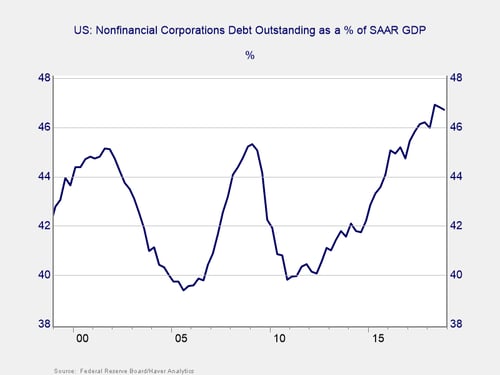 Recently, I’ve had a lot to say about debt. Back in December, at the height of the holiday season, I wrote about consumer debt and concluded that it really wasn’t a significant risk. That’s the good, relatively speaking. Government debt, which I discussed about a month ago, is a bigger risk. That is certainly a problem but not an immediate one. My best guess is that it becomes an immediate problem at some time in the next three to five years. That’s the bad. Now, it’s time to move on to the ugly—corporate debt. Here, the bad news comes in several flavors
Recently, I’ve had a lot to say about debt. Back in December, at the height of the holiday season, I wrote about consumer debt and concluded that it really wasn’t a significant risk. That’s the good, relatively speaking. Government debt, which I discussed about a month ago, is a bigger risk. That is certainly a problem but not an immediate one. My best guess is that it becomes an immediate problem at some time in the next three to five years. That’s the bad. Now, it’s time to move on to the ugly—corporate debt. Here, the bad news comes in several flavors
Debt level
First, let’s look at the amount of debt. As usual, we have to measure this amount against something; in this case, we will use the economy as a whole. As you can see from the chart below, the amount of debt for nonfinancial corporations (excluding, say, banks and insurance companies that use debt for different reasons) is at an all-time high. It is also well above the levels of 2001 and 2008. Purely from a debt level perspective, this amount is a risk. Also, note that when debt levels start to roll over, a crisis is generally not far behind—and we may be seeing just such a rollover.

Credit quality
Next, let’s look at credit quality. Generally speaking, A-rated bonds are investment quality, and BBB-rated bonds are also investment grade, although at the lower end. Right now, we have the proportion of investment-grade bonds that are BBB at more than half the total, an all-time high. And this is in a good time. What happens when a recession hits? If history is a guide, many companies will be downgraded, taking their debt out of investment grade and forcing many managers to sell. If that kind of forced selling hits, prices could drop sharply—and interest rates rise—especially if there isn’t a healthy supply of buyers.
Which there likely will not be. The quantity of buyers and sellers in the corporate bond market has collapsed, largely because the large banks were forced, for regulatory reasons, to substantially reduce their trading activities. According to J. P. Morgan, outstanding corporate debt more than doubled from 2006 to 2017, while the turnover volume dropped by nearly half. Any market sell-off would force a much bigger crowd through a much smaller gate, with the possibility of real damage.
Headed for a financial breakdown?
This scenario is the kind of systemic disruption that could, potentially, lead to a financial breakdown. Fortunately, there are reasons to believe any breakdown is not inevitable. Although debt volumes are high, debt payments are still relatively low compared with income and assets, due to persistently low interest rates. Second, debt typically comes due over time, which gives companies time to adjust. Third, this is a problem that, while not widely discussed in the press, is well known in the investment community. At this point, all the risks look manageable. Manageable or not, however, they are definitely there.
The real risk in the room
When we talk about debt, most of the discussion is around consumer or government debt. There are indeed reasons to be concerned, especially about government debt. The bus that hits you, however, is the one you aren’t looking for. Corporate debt could be just that bus. This debt is what we are watching here as the real risk in the room. It is one more reason to monitor the economy closely for recession risks because that is when the risk will become immediate.


 Print
Print

